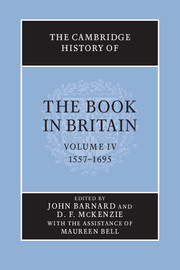Crossref Citations
This Book has been
cited by the following publications. This list is generated based on data provided by Crossref.
Poole, William
2004.
The Early Reception ofParadise Lost.
Literature Compass,
Vol. 1,
Issue. 1,
p.
**.
Raven, James
2005.
The Cambridge History of English Literature, 1660–1780.
p.
11.
Richetti, John
2005.
The Cambridge History of English Literature, 1660–1780.
Zwicker, Steven N.
2005.
The Cambridge History of English Literature, 1660–1780.
p.
132.
Roberts, Julian
2006.
The Cambridge History of Libraries in Britain and Ireland.
p.
36.
Feather, John
2006.
The Cambridge History of Libraries in Britain and Ireland.
p.
301.
Mandelbrote, Giles
and
Manley, K. A.
2006.
The Cambridge History of Libraries in Britain and Ireland.
Black, Alistair
2006.
Information history.
Annual Review of Information Science and Technology,
Vol. 40,
Issue. 1,
p.
441.
2007.
A Concise Companion to Shakespeare and the Text.
p.
239.
2007.
A History of Seventeenth‐Century English Literature.
p.
429.
Weedon, Alexis
2008.
A Companion to the History of the Book.
p.
33.
Yáñez‐Bouza, Nuria
2012.
Grammar Writing and Provincial Grammar Printing in the Eighteenth‐Century British Isles1.
Transactions of the Philological Society,
Vol. 110,
Issue. 1,
p.
34.
CLARK, J. C. D.
2012.
SECULARIZATION AND MODERNIZATION: THE FAILURE OF A ‘GRAND NARRATIVE’.
The Historical Journal,
Vol. 55,
Issue. 1,
p.
161.
Ruellet, Aurélien
2016.
La Maison de Salomon.
p.
305.
Wrightson, Keith
2017.
A Social History of England, 1500–1750.
Soares, Marina de Oliveira
2017.
O harém ao rés do chão: imaginário europeu e representações médicas sobre o lugar-segredo, 1599-1791.
Jowett, John
2019.
The Cambridge Guide to the Worlds of Shakespeare.
p.
323.
Bland, Mark
2019.
The Cambridge Guide to the Worlds of Shakespeare.
p.
335.
Braunmuller, A. R.
2019.
The Cambridge Guide to the Worlds of Shakespeare.
p.
1621.
Weedon, Alexis
2019.
A Companion to the History of the Book.
p.
31.



